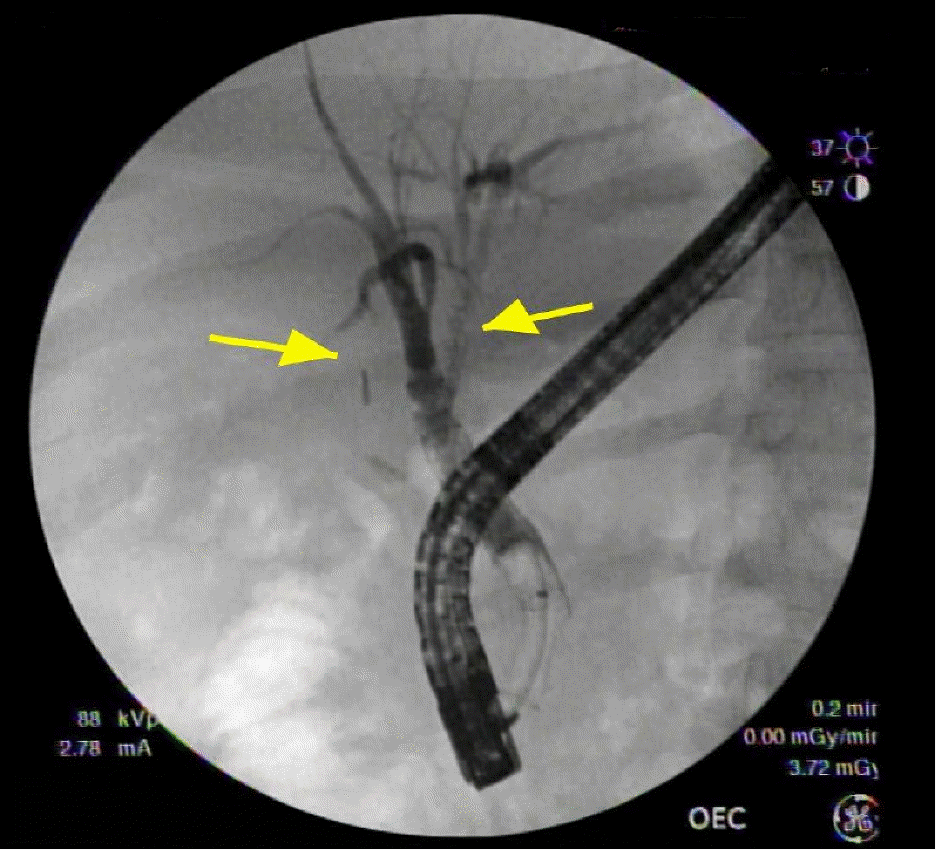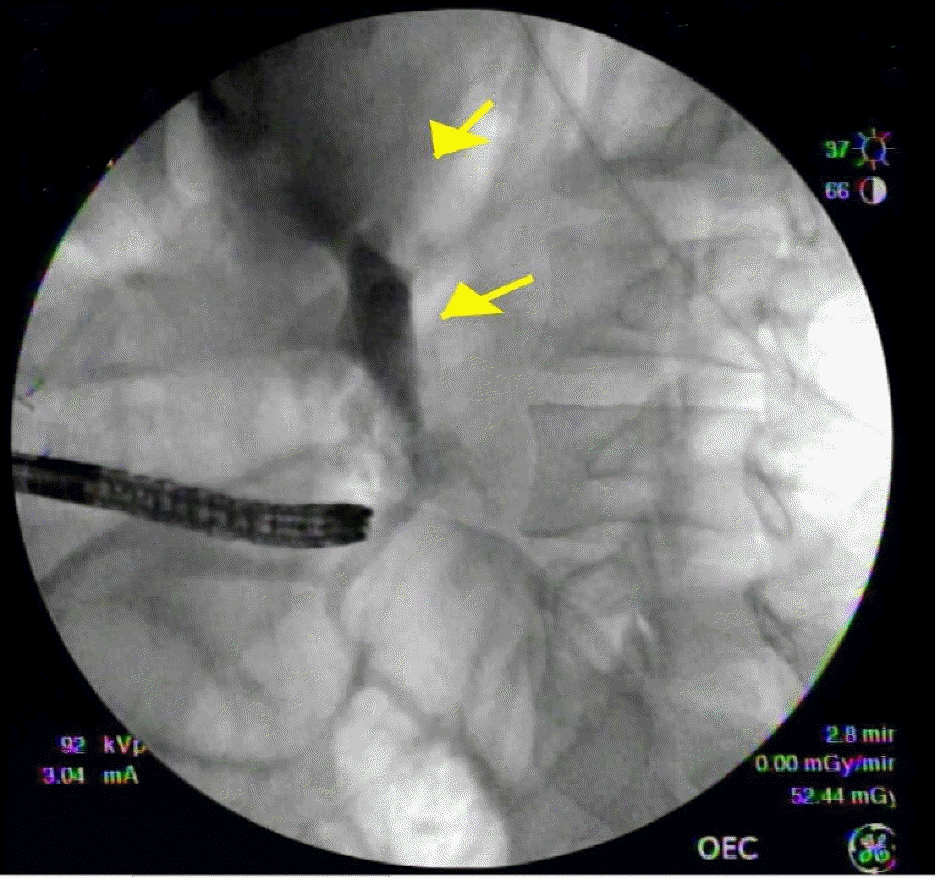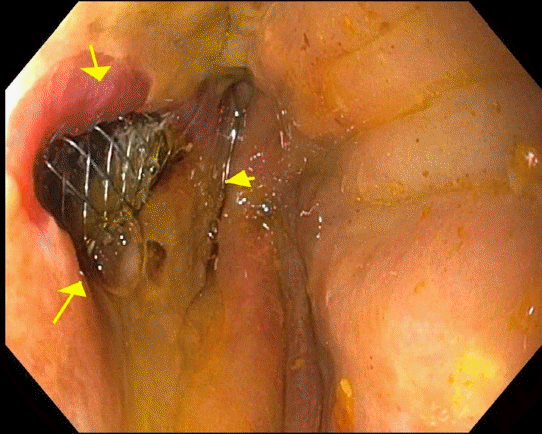Successful treatment of a refractory bile leak with endoclips during percutaneous necrosectomy
Article information
Biliary injuries, such as bile leaks and fistulas, are devastating complications of cholecystectomies. Although rare, they are associated with an increased risk of morbidity and mortality. There are various methods to proceed when one occurs, including stent placement and sphincterotomy via endoscopic retrograde cholangiopancreatography (ERCP) or percutaneous drainage. If these methods don’t succeed owing to complexity or other factors, additional methods, some unconventional methods, must be employed because of the danger of an active leak.
We present the case of a 36-year-old- male with a medical history of asthma, hypogonadism, and symptomatic cholelithiasis who underwent laparoscopic cholecystectomy at an outside community hospital. Intraoperative cholangiogram revealed choledocholithiasis, and ERCP was performed with stone removal by an advanced endoscopist at that facility. Upon discharge, the patient continued to experience smoldering abdominal pain that was initially controlled with pain medication. One week later, the patient was readmitted with worsening abdominal pain, and a large, infected, right-sided fluid collection was discovered. A computed tomography-guided percutaneous drain placement was performed before discharge. The patient was readmitted because of worsening abdominal pain and leukocytosis. Given the persistence of his symptoms and their complexity, he was transferred to our university hospital for evaluation by an advanced endoscopy team. Endoscopic ultrasound revealed a large peripancreatic necrotic collection, which was sampled and showed lipase >4,000 IU/L, bilirubin of 14.5 mg/dL, and fluid cultures positive for multidrug-resistant Pseudomonas. ERCP was performed and showed a large-caliber common hepatic duct leak. An 8×8 cm covered metal biliary stent was placed within the common bile duct, as well as an 18×10 cm covered esophageal stent in the right lower quadrant, across the cystostomy, for percutaneous endoscopic necrosectomy. Subsequently, an increased drain output of 1,425 mL was noticed, and the hepatobiliary iminodiacetic acid scan showed a persistent active bile leak near the location of peripancreatic fluid collection. Repeat ERCP revealed that the previously placed stent had migrated, and there was extravasation of contrast from the common hepatic duct before repositioning of the transpapillary biliary stent. Percutaneous endoscopic necrosectomy was performed. After successful clearance of the cavity, a concomitant 2 cm bile duct wall defect was discovered upon exposure to the metal biliary stent (Fig. 1). This biliary leak requires a dual approach because of its large size. Two endoclips were used to approximate the wall defect, and a fully covered metal stent was left in the common bile duct to seal the defect from the inside and direct the bile into the duodenum (Figs. 2, 3). This presentation, in conjunction with the composition of the collection, was suggestive of a fistula between the common bile duct and peripancreatic fluid collection. The injury was found in the common bile duct rather than the cystic duct remnant, and the lack of visualization of the leak on initial ERCP supports this. The patient’s persistent intractable symptoms after cholecystectomy were explained by pancreatitis caused by the pancreatic pseudocyst.

Endoscopic view after the bile duct wall defect was repaired with endoclips via a percutaneous approach. Arrow demonstrates the repaired bile duct wall defect.
On follow-up computed tomography three weeks later, the right-sided collection had resolved. Repeat ERCP at three and five months showed no further contrast extravasation or bile duct stricture (Fig. 4). The metal stent was removed five months after the initial placement without any further complications.

Fluoroscopic image 3 months after percutaneous repair of common bile duct defect with endoclips with no contrast extravasation. Arrows demonstrate lack of contrast extravasation, consistent with repaired common bile duct.
Laparoscopic cholecystectomies are a relatively safe procedure with few adverse events. Biliary injury is rare, but it is possible and problematic. According to literature, laparoscopic cholecystectomies are even more likely to cause biliary injuries than open cholecystectomies.1 In the 1990s, the risk of biliary injury post-cholecystectomy approached 0.72%.2 More recently, studies have shown ranges of biliary injury of 0.08% to 0.5%.1,3,4 Biliary injury can result in fistulas, peritonitis, or bilomas, as in this case presentation.3 The risk of bile duct injury increases with certain factors such as emergent admissions, choledocholithiasis, and acute cholecystitis.1,4
The sequelae of biliary injuries include an increased length of hospital stay. One study reported an average hospital stay of 17 days for post-cholecystectomy biliary leak compared to four days in the control group.4 An increased length of hospital stay can result in many factors, including an increased risk of hospital-acquired infection. On a related note, biliary leaks can lead to increased morbidity and mortality in patients.3,4 In one retrospective study of over 150,000 laparoscopic cholecystectomies, 125 biliary injuries occurred. In these patients, all-cause mortality was 20.8%. This was an 8.8% increase in mortality compared to patients in the cohort who did not have common bile duct injury.3
Biliary injuries were previously treated surgically; however, ERCP is now the standard treatment. This works by decreasing the pressure gradient between the bile duct and duodenum, encouraging transpapillary bile flow.5 Placement of stents and/or biliary sphincterotomy are the typical treatment options. In one study, a combination of these two treatments resulted in a success rate of over 91%.5 How to proceed when difficult or complex biliary leaks occur is, however, not so clear. Some studies have speculated that using a fully covered self-expandable metal stent or upsizing/addition of more plastic stents could be efficacious.5 There are no clear guidelines for refractory biliary leaks; however, many necessitate multiple reinterventions.4
This case illustrates a novel approach that successfully treated a fistula between the bile duct and a pseudocyst with endoclips during percutaneous necrosectomy. Although undocumented in literature, complex refractory biliary injuries require unconventional methods. This case proved successful in a young but complicated patient and should be explored further.
Notes
Conflicts of Interest
The authors have no potential conflicts of interest.
Funding
None.
Author Contributions
Conceptualization: PAMA, NR, SS, NH, RM, TCP; Supervision: PAMA, RM, TCP; Visualization: all authors; Writing–original draft: KCKY, PAMA, SS, NH; Writing– review & editing: all authors.


